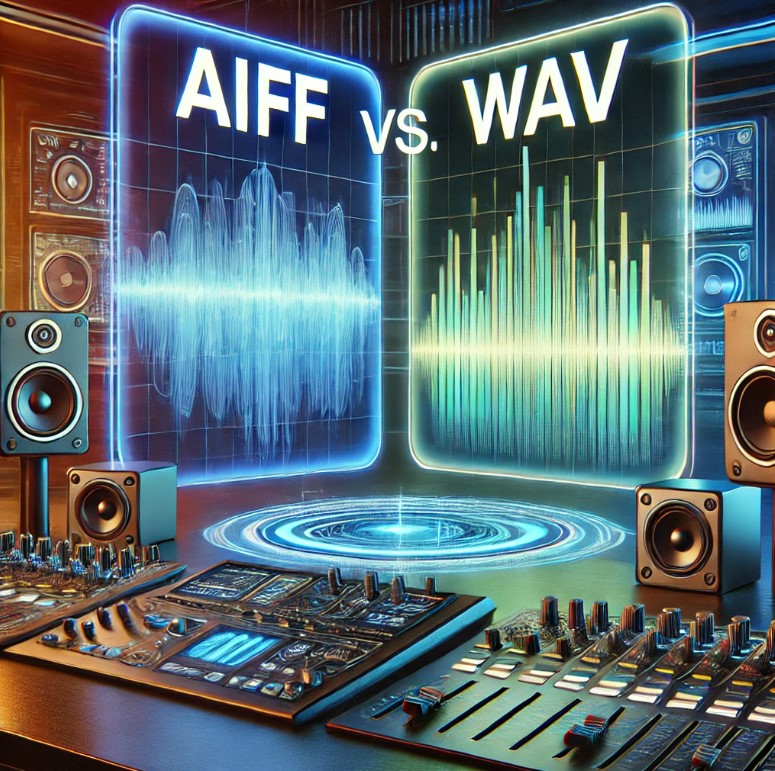Introduction
AIFF (Audio Interchange File Format) and WAV (Waveform Audio File Format) are two of the most commonly used uncompressed audio file formats in digital media. Despite serving similar purposes, they cater to different user preferences and workflows. This article provides a thorough examination of these formats to help you better understand their functionalities, origins, and practical applications.
What Are AIFF and WAV?
AIFF is an audio file format developed by Apple in 1988. Designed to store high-quality audio data, Aiff versus wav is predominantly used in macOS and iOS systems. It is based on the Interchange File Format (IFF), providing flexibility and compatibility for media exchange.
WAV, created by Microsoft and IBM in 1991, is the standard audio format for PCs. It operates under the Resource Interchange File Format (RIFF) structure, enabling it to store raw audio data with minimal compression. Both formats prioritize preserving audio fidelity over file size reduction.
The Purpose Behind Their Creation
The development of Aiff versus wav was driven by Apple’s goal to provide a professional-grade audio solution for Macintosh users. By offering excellent audio quality, AIFF quickly became the default choice for music producers and audio engineers using Apple devices.
Conversely, WAV was introduced as part of Windows’ multimedia capabilities. It aimed to provide a robust platform for audio editing and playback on Windows-based systems. WAV’s compatibility with a wide range of software made it a go-to option for audio professionals working in the PC ecosystem.
Compatibility and Platform Preferences
One of the most significant differences between AIFF and WAV is their platform compatibility. AIFF is optimized for Apple environments, seamlessly integrating with macOS and iOS devices. This makes it a preferred choice for Apple users.
WAV, on the other hand, is inherently tied to Windows systems. Although both formats can be used across platforms, AIFF is better suited for Apple-based workflows, while WAV excels in Windows environments. Cross-platform users often choose WAV due to its broader software support.
Audio Quality and Fidelity
Both AIFF and WAV are renowned for their ability to store high-fidelity audio data. Since neither format compresses audio files, the quality remains pristine, making them ideal for professional audio editing and production.
However, subtle differences exist. AIFF supports metadata, enabling users to include additional information such as artist names, track titles, and album artwork. WAV, although equally capable of storing high-quality audio, lacks advanced metadata capabilities, which can be a limitation for some users.
File Size Considerations
One common drawback of AIFF and WAV files is their large file sizes. Both formats prioritize audio quality, storing raw, uncompressed audio data. A three-minute song in either format can easily exceed 30 MB, making them less suitable for casual use or streaming.
Despite their similarities in size, AIFF files may include metadata, slightly increasing their overall file size compared to WAV files. This difference is often negligible but can be a consideration for projects with strict storage constraints.
Use Cases in Audio Production
AIFF and WAV are both widely used in professional audio environments, but their use cases often depend on the platform. AIFF is favored by music producers and sound engineers working in Apple ecosystems, particularly those using Logic Pro or GarageBand.
WAV is the standard in Windows-based studios, frequently employed for editing, mixing, and mastering audio. Its widespread compatibility ensures smooth integration with most Digital Audio Workstations (DAWs) and software plugins, regardless of the platform.
Modern Relevance in an AI-Driven World
As artificial intelligence (AI) technologies revolutionize audio processing, AIFF and WAV remain integral in training and implementing AI models. Their uncompressed nature allows AI systems to analyze audio with minimal distortion, making them essential for applications like speech recognition, music generation, and sound design.
AI tools also leverage these formats for tasks like noise reduction and audio restoration. Whether it’s AIFF or WAV, the format you choose should align with your system and project requirements to maximize efficiency in AI-driven workflows.
Choosing Between AIFF and WAV
When deciding between AIFF and WAV, consider your platform, workflow, and intended use. Apple users may find AIFF more convenient due to its seamless integration and metadata capabilities. Windows users, or those requiring broader compatibility, often prefer WAV.
For projects involving cross-platform collaboration, WAV’s universal acceptance makes it a safer choice. However, if metadata is crucial, AIFF might be worth the extra steps to ensure compatibility across systems.
Read Also: Why iTransmission is the Best App for iOS Users
The Future of AIFF and WAV
In an era dominated by streaming and cloud storage, AIFF and WAV face competition from compressed formats like MP3 and AAC. However, their relevance persists in professional settings, where audio quality is paramount. As AI technologies evolve, both formats will likely continue to play vital roles in high-quality audio processing and analysis.
In summary, the choice between AIFF and WAV depends on your specific needs. By understanding their strengths and limitations, you can make an informed decision for your next audio project.
Conclusion
AIFF and WAV are two leading uncompressed audio formats, each with unique strengths catering to different user needs. AIFF shines in Apple ecosystems, offering seamless integration and robust metadata support, making it ideal for Mac-based workflows. WAV, on the other hand, is the universal standard, with unmatched compatibility across platforms and software.
In modern audio production and AI-driven technologies, both formats continue to play critical roles, offering pristine audio quality essential for professional and technical applications. While their large file sizes may limit casual use, their fidelity ensures they remain invaluable in areas where quality cannot be compromised.
Ultimately, your choice between Aiff versus wav and WAV should align with your platform, workflow, and project requirements. By leveraging the right format, you can achieve optimal results, whether you’re producing music, analyzing audio with AI, or mastering high-quality sound for professional use.



